实时 摔倒识别 / 运动分析 / 打架等异常行为识别 / 控制手势识别等所有行为识别全家桶 原理 + 代码 + 数据 + 模型 开源!
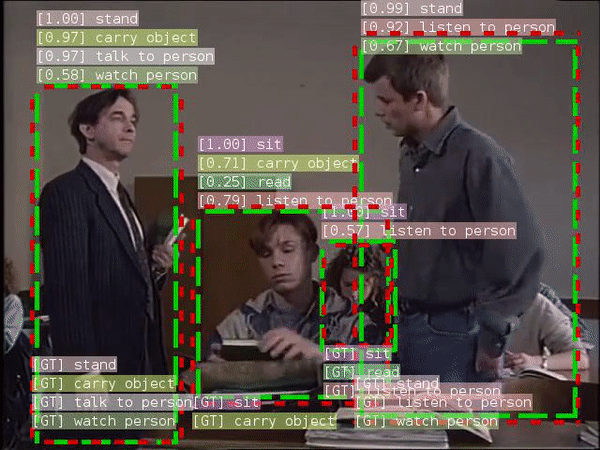
大家好,我是 cv 君,很多大创,比赛,项目,工程,科研,学术的炼丹术士问我上述这些识别,该怎么做,怎么选择框架,今天可以和大家分析一下一些方案:
用单帧目标检测做的话,前后语义相关性很差(也有优化版),效果不能达到实际项目需求,尤其是在误检上较难,并且目标检测是需要大量数据来拟合的。标注需求极大。
用姿态加目标检测结合的方式,效果是很不错的,不过一些这样类似 Two stage 的方案,速度较慢(也有很多实时的),同样有着一些不能通过解决时间上下文的问题。
即:摔倒检测 我们正常是应该有一个摔倒过程,才能被判断为摔倒的,而不是人倒下的就一定是摔倒(纯目标检测弊病)
运动检测 比如引体向上,和高抬腿计数,球类运动,若是使用目标检测做,那么会出现什么问题呢? 引体向上无法实现动作是否规范(当然可以通过后处理判断下巴是否过框,效果是不够人工智能的),高抬腿计数,目标检测是无法计数的,判断人物的球类运动,目标检测是有很大的误检的:第一种使用球检测,误检很大,第二种使用打球手势检测,遇到人物遮挡球类,就无法识别目标,在标注上也需要大量数据…
今天 cv 君铺垫了这么多,只是为了给大家推荐一个全新出炉视频序列检测方法,目前代码已开源至 Github:https://github.com/CVUsers/CV-Action欢迎 star~
欢迎移步。只需要很少的训练数据,就可以拟合哦!不信你来试试吧~几个训练集即可。
神经网络使用的是这两个月开源的实时动作序列强分类神经网络:realtimenet 。
我的 github 将收集 所有的上述说到的动作序列视频数据,训练出能实用的检测任务:目前实现了手势控制的检测,等等,大家欢迎关注公众号,后续会接着更新。
开始
目前以手势和运动识别为例子,因为 cv 君没什么数据哈哈
项目演示:
本人做的没转 gif,所以大家可以看看其他的演示效果图,跟我的是几乎一样的~ 只是训练数据不同
在这里插入图片描述在这里插入图片描述
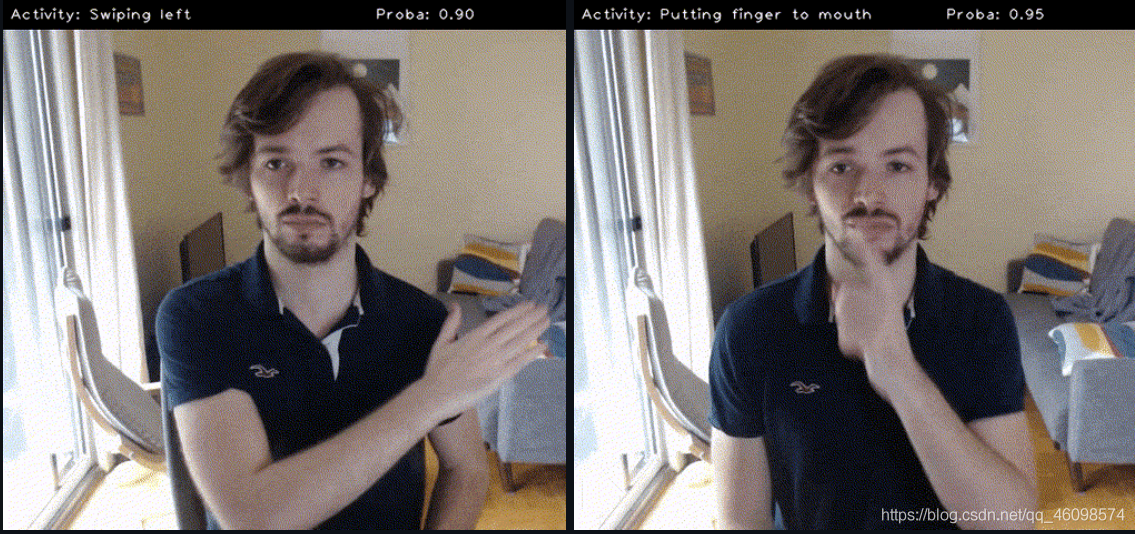
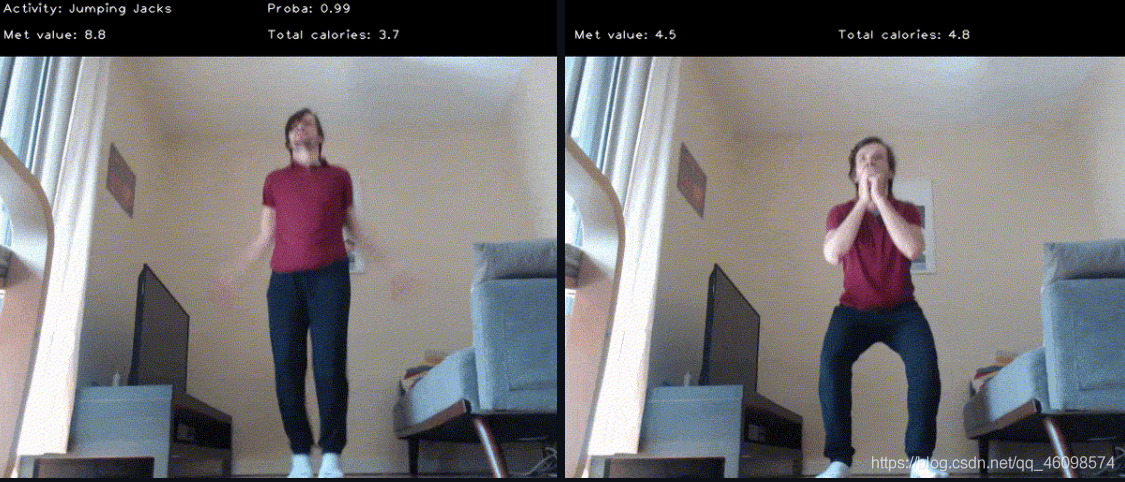
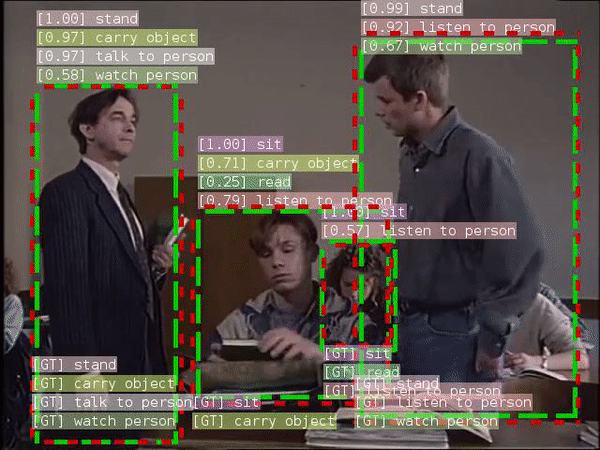
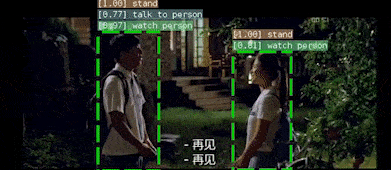
一、 基本过程和思想
基本思想是将数据集中视频及分类标签转换为图像(视频帧)和其对应的分类标签,也可以不标注,单独给一个小视频标注上分类类别,再采用 CNN 网络对图像进行训练学习和测试,将视频分类问题转化为图形分类问题。具体步骤包括:
(1) 对每个视频(训练和测试视频)以一定的 FPS 截出视频帧(jpegs)保存为训练集和测试集,将对图像的分类性能作为所对应视频的分类性能
(2)训练一个人物等特征提取模型,并采用模型融合策略,一个特征提取,一个分类模型。特征工程部分通用人物行为,分类模型,训练自己的类别的分类模型即可。
(4) 训练完成后载入模型对 test set 内所有的视频帧进行检查验证,得出全测试集上的 top1 准确率和 top5 准确率输出。
(5)实时检测。
二 、视频理解还有哪些优秀框架
第一个 就是我 github 这个了,比较方便,但不敢排前几,因为没有什么集成,
然后 MMaction ,就是视频理解框架了,众所周知,他们家的东西很棒
第二个就是 facebook 家的一些了,
再下来基本上就不多了,全面好用的实时框架。
好,所以我们先来说说我的使用过程。
三、效果体验~使用
体验官方的一些模型 (模型我已经放在里面了)
pip install -r requirements.txt
将模型放置此处:
resources
├── backbone
│ ├── stridedinflatedefficientnet.ckpt
│ └── stridedinflatedmobilenet.ckpt
├── fitnessactivityrecognition
│ └── ...
├── gesture_recognition
│ └── ...
└── ...
首先,请试用我们提供的演示。在 sense/examples 目录中,您将找到 3 个 Python 脚本, rungesturerecognition.py ,健身跟踪器 runfitnesstracker.py .py,并运行卡路里估算 runcalorieestimation .py. 启动每个演示就像在终端中运行脚本一样简单,如下所述。
手势:
cd examples/
python rungesturerecognition.py
健身_跟踪器:
python examples/runfitnesstracker.py --weight=65 --age=30 --height=170 --gender=female
--cameraid=CAMERAID ID of the camera to stream from
--path_in=FILENAME Video file to stream from. This assumes that the video was encoded at 16 fps.
卡路里计算
python examples/runcalorieestimation.py --weight=65 --age=30 --height=170 --gender=female
三、训练自己数据集步骤
首先 clone 一下我的 github,或者原作者 github,
然后自己录制几个视频,比如我这里 capture 一个类别,录制了几个视频,可以以 MP4 或者 avi 后缀,再来个类别,再录制一些视频,以名字为类别。
然后
cd tools\sensestudio\sensestudio.py
这一步,会显示:
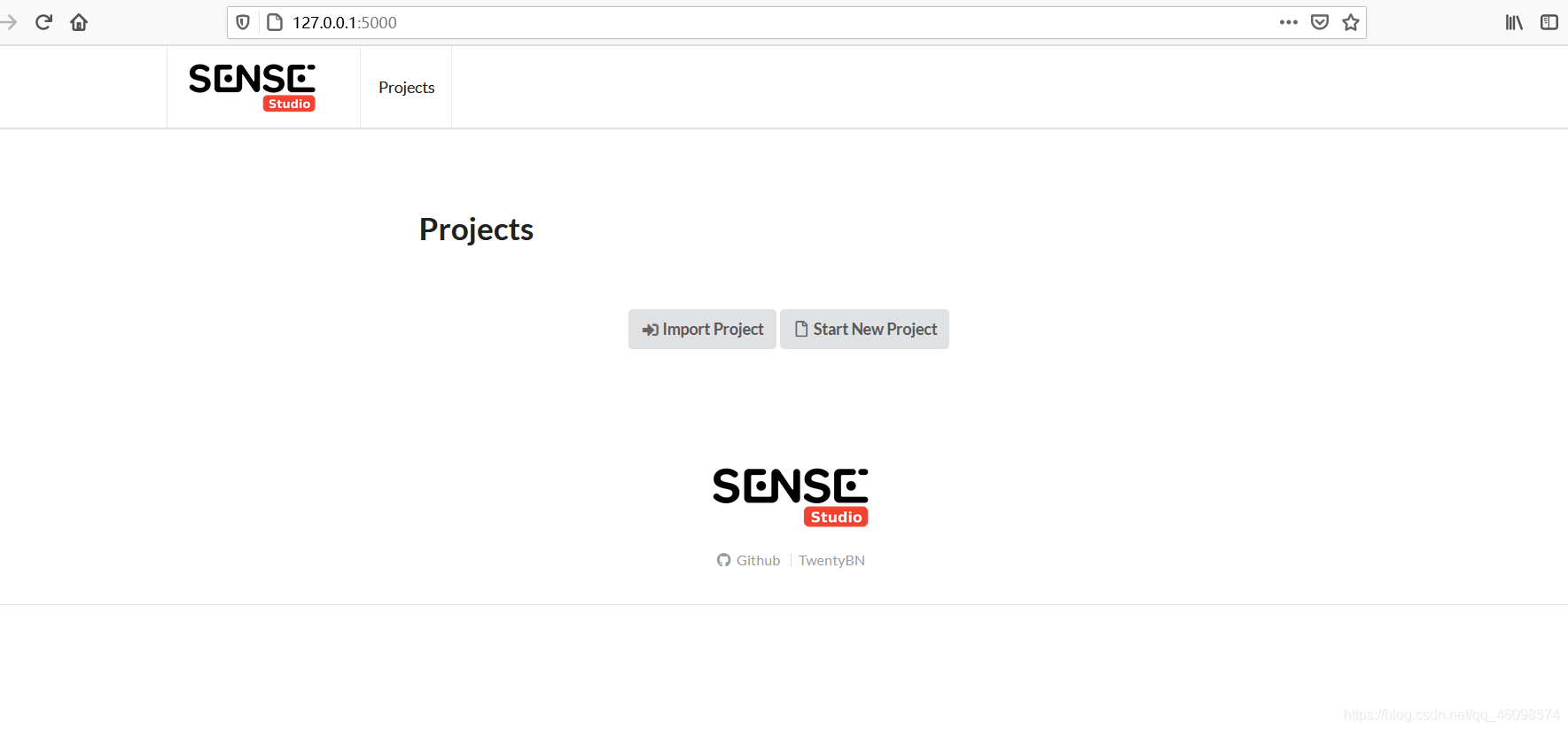
然后,打开这个网址:
来到前端界面
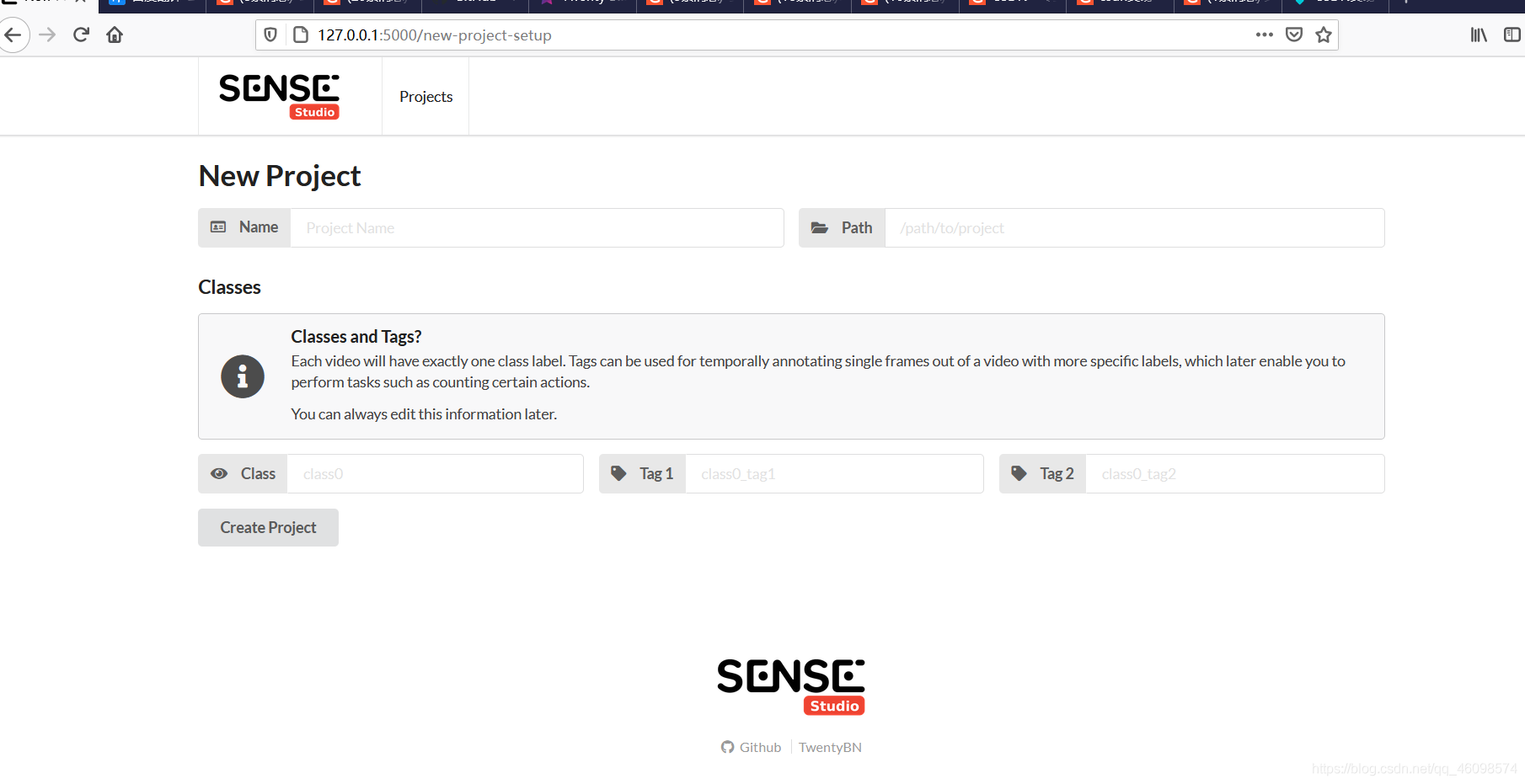
点击一下 start new project

这样编写
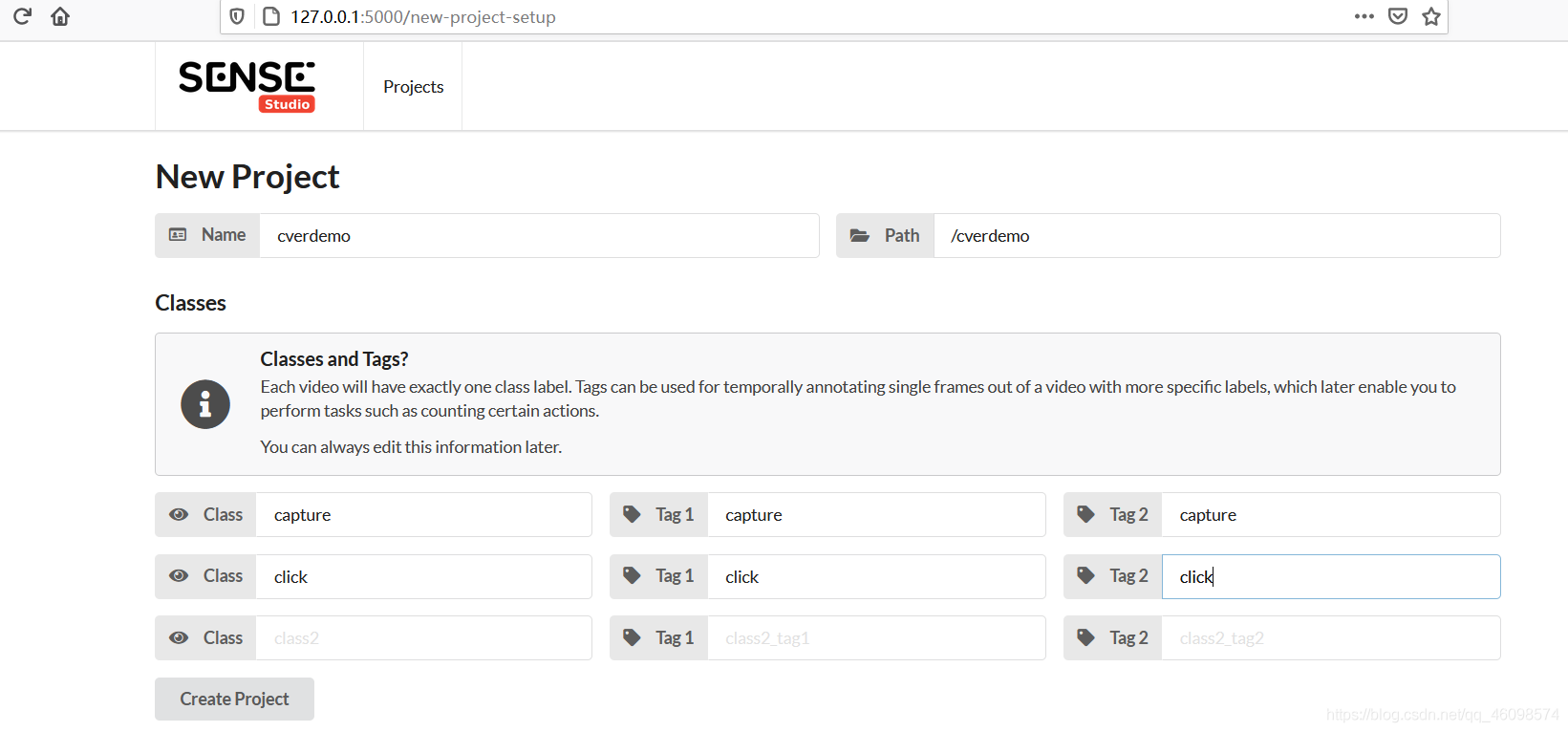
然后点击 create project 即可制作数据。
但是官方的制作方法是有着严重 bug 的~我们该怎么做呢!
下面,我修改后,可以这样!
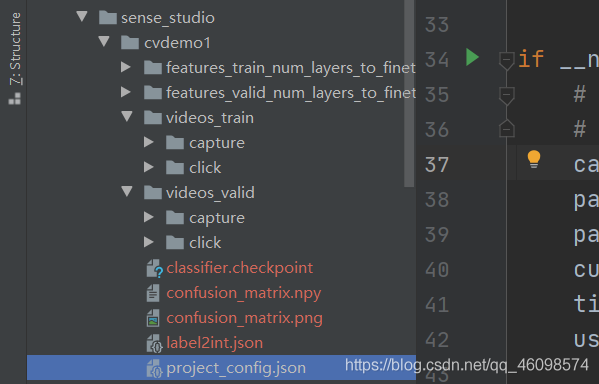
这里请仔细看:
我们在 sense_studio 文件夹下,新建一个文件夹:我叫他 cvdemo1
然后新建两个文件夹:videostrain 和 videosvalid 里面存放的 capture 是你的类别名字的数据集,capture 存放相关的训练集,click 存放 click 的训练集,同样的 videos_valid 存放验证集,
在 cvdemo1 文件夹下新建 project_config.json ,里面写什么呢? 可以复制我的下面的代码:
{
"name": "cvdemo1",
"date_created": "2021-02-03",
"classes": {
"capture": [
"capture",
"capture"
],
"click": [
"click",
"click"
]
}
}
里面的 name 改成你的文件夹名字即可。
就这么简单!
然后就可以训练:
python train_classifier.py 你可以将 main 中修改一下。
将 path in 修改成我们的训练数据地址,即可,其他的修改不多,就按照我的走即可,
# Parse arguments
# args = docopt(doc)
pathin = './sensestudio/cvdemo1/'
pathout = pathin
os.makedirs(pathout, existok=True)
use_gpu = True
pathannotationstrain = None
pathannotationsvalid =None
numlayersto_finetune = 9
temporal_training = False
# Load feature extractor
featureextractor = featureextractors.StridedInflatedEfficientNet()
checkpoint = torch.load('../resources/backbone/stridedinflatedefficientnet.ckpt')
featureextractor.loadstate_dict(checkpoint)
feature_extractor.eval()
# Get the require temporal dimension of feature tensors in order to
# finetune the provided number of layers.
if numlayersto_finetune > 0:
numtimesteps = featureextractor.numrequiredframesperlayer.get(-numlayersto_finetune)
if not num_timesteps:
# Remove 1 because we added 0 to temporal_dependencies
numlayers = len(featureextractor.numrequiredframesperlayer) - 1
raise IndexError(f'Num of layers to finetune not compatible. '
f'Must be an integer between 0 and {num_layers}')
else:
num_timesteps = 1
训练特别快,10 分钟即可,
然后,你可以运行 runcustomclassifier.py
# Parse arguments
# args = docopt(doc)
camera_id = 0
path_in = None
path_out = None
customclassifier = './sensestudio/cvdemo1/'
title = None
use_gpu = True
# Load original feature extractor
featureextractor = featureextractors.StridedInflatedEfficientNet()
featureextractor.loadweightsfromresources('../resources/backbone/stridedinflatedefficientnet.ckpt')
# featureextractor = featureextractors.StridedInflatedMobileNetV2()
# featureextractor.loadweightsfromresources(r'../resources\backbone\stridedinflatedmobilenet.ckpt')
checkpoint = featureextractor.statedict()
# Load custom classifier
checkpointclassifier = torch.load(os.path.join(customclassifier, 'classifier.checkpoint'))
# Update original weights in case some intermediate layers have been finetuned
namefinetunedlayers = set(checkpoint.keys()).intersection(checkpoint_classifier.keys())
for key in namefinetunedlayers:
checkpoint[key] = checkpoint_classifier.pop(key)
featureextractor.loadstate_dict(checkpoint)
feature_extractor.eval()
print('[debug] net:', feature_extractor)
with open(os.path.join(custom_classifier, 'label2int.json')) as file:
class2int = json.load(file)
INT2LAB = {value: key for key, value in class2int.items()}
gestureclassifier = LogisticRegression(numin=featureextractor.featuredim,
num_out=len(INT2LAB))
gestureclassifier.loadstatedict(checkpointclassifier)
gesture_classifier.eval()
print(gesture_classifier)
同样修改路径即可。
结果就可以实时检测了
原代码解读
同样的,我们使用的是使用 efficienct 来做的特征,你也可以改成 mobilenet 来做,有示例代码,就是训练的时候,用 mobilenet ,检测的时候也是,只需要修改几行代码即可。
efficienct 提取特征部分代码:
class StridedInflatedEfficientNet(StridedInflatedMobileNetV2):
def init(self):
super().init()
self.cnn = nn.Sequential(
ConvReLU(3, 32, 3, stride=2),
InvertedResidual(32, 24, 3, spatial_stride=1),
InvertedResidual(24, 32, 3, spatialstride=2, expandratio=6),
InvertedResidual(32, 32, 3, spatialstride=1, expandratio=6, temporal_shift=True),
InvertedResidual(32, 32, 3, spatialstride=1, expandratio=6),
InvertedResidual(32, 32, 3, spatialstride=1, expandratio=6),
InvertedResidual(32, 56, 5, spatialstride=2, expandratio=6),
InvertedResidual(56, 56, 5, spatialstride=1, expandratio=6, temporalshift=True, temporalstride=True),
InvertedResidual(56, 56, 5, spatialstride=1, expandratio=6),
InvertedResidual(56, 56, 5, spatialstride=1, expandratio=6),
InvertedResidual(56, 112, 3, spatialstride=2, expandratio=6),
InvertedResidual(112, 112, 3, spatialstride=1, expandratio=6, temporal_shift=True),
InvertedResidual(112, 112, 3, spatialstride=1, expandratio=6),
InvertedResidual(112, 112, 3, spatialstride=1, expandratio=6),
InvertedResidual(112, 112, 3, spatialstride=1, expandratio=6, temporalshift=True, temporalstride=True),
InvertedResidual(112, 112, 3, spatialstride=1, expandratio=6),
InvertedResidual(112, 160, 5, spatialstride=1, expandratio=6),
InvertedResidual(160, 160, 5, spatialstride=1, expandratio=6, temporal_shift=True),
InvertedResidual(160, 160, 5, spatialstride=1, expandratio=6),
InvertedResidual(160, 160, 5, spatialstride=1, expandratio=6),
InvertedResidual(160, 160, 5, spatialstride=1, expandratio=6, temporal_shift=True),
InvertedResidual(160, 160, 5, spatialstride=1, expandratio=6),
InvertedResidual(160, 272, 5, spatialstride=2, expandratio=6),
InvertedResidual(272, 272, 5, spatialstride=1, expandratio=6, temporal_shift=True),
InvertedResidual(272, 272, 5, spatialstride=1, expandratio=6),
InvertedResidual(272, 272, 5, spatialstride=1, expandratio=6, temporal_shift=True),
InvertedResidual(272, 272, 5, spatialstride=1, expandratio=6),
InvertedResidual(272, 272, 5, spatialstride=1, expandratio=6),
InvertedResidual(272, 272, 5, spatialstride=1, expandratio=6),
InvertedResidual(272, 272, 5, spatialstride=1, expandratio=6),
InvertedResidual(272, 448, 3, spatialstride=1, expandratio=6),
ConvReLU(448, 1280, 1)
)
这个 InvertedResidual 在这,
class InvertedResidual(nn.Module): # noqa: D101
def init(self, inplanes, outplanes, spatialkernelsize=3, spatialstride=1, expandratio=1,
temporalshift=False, temporalstride=False, sparsetemporalconv=False):
super().init()
assert spatial_stride in [1, 2]
hiddendim = round(inplanes * expand_ratio)
self.useresidual = spatialstride == 1 and inplanes == outplanes
self.temporalshift = temporalshift
self.temporalstride = temporalstride
layers = []
if expand_ratio != 1:
# Point-wise expansion
stride = 1 if not temporal_stride else (2, 1, 1)
if temporalshift and sparsetemporal_conv:
convlayer = SteppableSparseConv3dAs2d
kernel_size = 1
elif temporal_shift:
convlayer = SteppableConv3dAs2d
kernel_size = (3, 1, 1)
else:
convlayer = nn.Conv2d
kernel_size = 1
layers.append(ConvReLU(inplanes, hiddendim, kernelsize=kernelsize, stride=stride,
padding=0, convlayer=convlayer))
layers.extend([
# Depth-wise convolution
ConvReLU(hiddendim, hiddendim, kernelsize=spatialkernelsize, stride=spatialstride,
groups=hidden_dim),
# Point-wise mapping
nn.Conv2d(hiddendim, outplanes, 1, 1, 0),
# nn.BatchNorm2d(out_planes)
])
self.conv = nn.Sequential(*layers)
def forward(self, input_): # noqa: D102
output = self.conv(input)
residual = self.realign(input, output)
if self.use_residual:
output_ += residual
return output_
def realign(self, input, output): # noqa: D102
nout = output.shape[0]
if self.temporal_stride:
indices = [-1 - 2 * idx for idx in range(n_out)]
return input_[indices[::-1]]
else:
return input[-nout:]
我们 finetune 自己的数据集
def extractfeatures(pathin, net, numlayersfinetune, usegpu, numtimesteps=1):
# Create inference engine
inferenceengine = engine.InferenceEngine(net, usegpu=use_gpu)
# extract features
for dataset in ["train", "valid"]:
videosdir = os.path.join(pathin, f"videos_{dataset}")
featuresdir = os.path.join(pathin, f"features{dataset}num_layers_tofinetune={numlayers_finetune}")
videofiles = glob.glob(os.path.join(videosdir, "", ".avi"))
print(f"\nFound {len(video_files)} videos to process in the {dataset}set")
for videoindex, videopath in enumerate(video_files):
print(f"\rExtract features from video {videoindex + 1} / {len(videofiles)}",
end="")
pathout = videopath.replace(videosdir, featuresdir).replace(".mp4", ".npy")
if os.path.isfile(path_out):
print("\n\tSkipped - feature was already precomputed.")
else:
# Read all frames
computefeatures(videopath, pathout, inferenceengine,
numtimesteps=numtimesteps, pathframes=None, batchsize=16)
print('\n')
构建数据的 dataloader
def generatedataloader(datasetdir, featuresdir, tagsdir, labelnames, label2int,
label2inttemporalannotation, numtimesteps=5, batchsize=16, shuffle=True,
stride=4, pathannotations=None, temporalannotation_only=False,
fullnetworkminimumframes=MODELTEMPORAL_DEPENDENCY):
# Find pre-computed features and derive corresponding labels
tagsdir = os.path.join(datasetdir, tags_dir)
featuresdir = os.path.join(datasetdir, features_dir)
labels_string = []
temporal_annotation = []
if not path_annotations:
# Use all pre-computed features
features = []
labels = []
for label in label_names:
featuretemp = glob.glob(f'{featuresdir}/{label}/*.npy')
features += feature_temp
labels += [label2int[label]] * len(feature_temp)
labelsstring += [label] * len(featuretemp)
else:
with open(path_annotations, 'r') as f:
annotations = json.load(f)
features = ['{}/{}/{}.npy'.format(features_dir, entry['label'],
os.path.splitext(os.path.basename(entry['file']))[0])
for entry in annotations]
labels = [label2int[entry['label']] for entry in annotations]
labels_string = [entry['label'] for entry in annotations]
# check if annotation exist for each video
for label, feature in zip(labels_string, features):
classemapping = {0: "countingbackground",
1: f'{label}position1', 2:
f'{label}position2'}
temporalannotationfile = feature.replace(featuresdir, tagsdir).replace(".npy", ".json")
if os.path.isfile(temporalannotationfile):
annotation = json.load(open(temporalannotationfile))["time_annotation"]
annotation = np.array([label2inttemporalannotation[classe_mapping[y]] for y in annotation])
temporal_annotation.append(annotation)
else:
temporal_annotation.append(None)
if temporalannotationonly:
features = [x for x, y in zip(features, temporal_annotation) if y is not None]
labels = [x for x, y in zip(labels, temporal_annotation) if y is not None]
temporalannotation = [x for x in temporalannotation if x is not None]
# Build dataloader
dataset = FeaturesDataset(features, labels, temporal_annotation,
numtimesteps=numtimesteps, stride=stride,
fullnetworkminimumframes=fullnetworkminimumframes)
dataloader = torch.utils.data.DataLoader(dataset, shuffle=shuffle, batchsize=batch_size)
return data_loader
如何实时检测视频序列的?
这个问题,主要是通过 系列时间内帧间图像组合成一个序列,送到网络中进行分类的,可以在许多地方找到相关参数,比如 display.py :
class DisplayClassnameOverlay(BaseDisplay):
"""
Display recognized class name as a large video overlay. Once the probability for a class passes the threshold,
the name is shown and stays visible for a certain duration.
"""
def init(
self,
thresholds: Dict[str, float],
duration: float = 2.,
font_scale: float = 3.,
thickness: int = 2,
border_size: int = 50,
**kwargs
):
"""
:param thresholds:
Dictionary of thresholds for all classes.
:param duration:
Duration in seconds how long the class name should be displayed after it has been recognized.
:param font_scale:
Font scale factor for modifying the font size.
:param thickness:
Thickness of the lines used to draw the text.
:param border_size:
Height of the border on top of the video display. Used for correctly centering the displayed class name
on the video.
"""
super().init(**kwargs)
self.thresholds = thresholds
self.duration = duration
self.fontscale = fontscale
self.thickness = thickness
self.bordersize = bordersize
self.currentclass_name = None
self.starttime = None
def getcenter_coordinates(self, img: np.ndarray, text: str):
textsize = cv2.getTextSize(text, FONT, self.font_scale, self.thickness)[0]
height, width, _ = img.shape
height -= self.border_size
x = int((width - textsize[0]) / 2)
y = int((height + textsize[1]) / 2) + self.border_size
return x, y
def displayclassname(self, img: np.ndarray, classname: str):
pos = self.getcentercoordinates(img, classname)
puttext(img, classname, position=pos, fontscale=self.fontscale, thickness=self.thickness)
def display(self, img: np.ndarray, display_data: dict):
now = time.perf_counter()
if self.currentclassname and now - self.start_time < self.duration:
# Keep displaying the same class name
self.displayclassname(img, self.currentclassname)
else:
self.currentclass_name = None
for classname, proba in displaydata['sorted_predictions']:
if classname in self.thresholds and proba > self.thresholds[classname]:
# Display new class name
self.displayclassname(img, classname)
self.currentclassname = classname
self.starttime = now
break
return img

对了
每个类别只需要 5 个左右的视频,即可得到不错的效果嗷~
欢迎 Star github~
因为后续会更新标题的所有模型。
版权声明: 本文为 InfoQ 作者【cv君】的原创文章。
原文链接:【http://xie.infoq.cn/article/ca89527294edbc5b16c03d235】。文章转载请联系作者。












评论